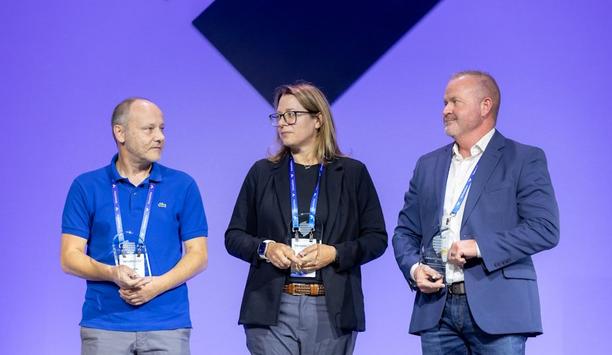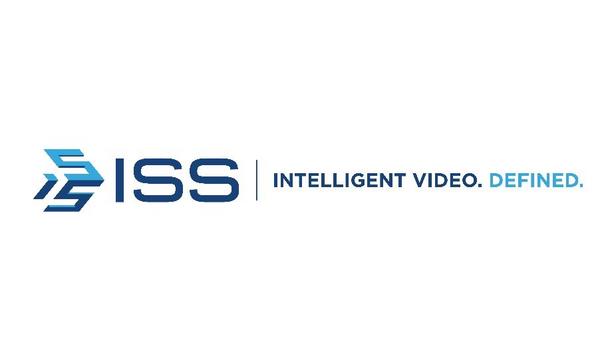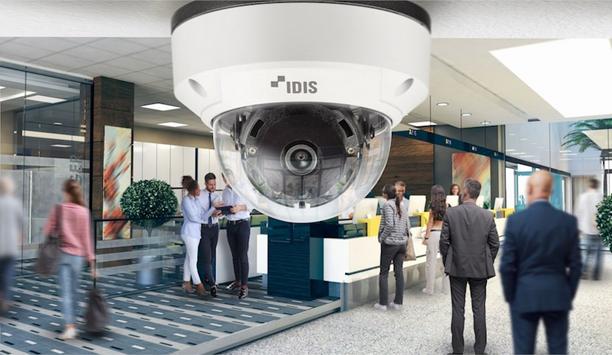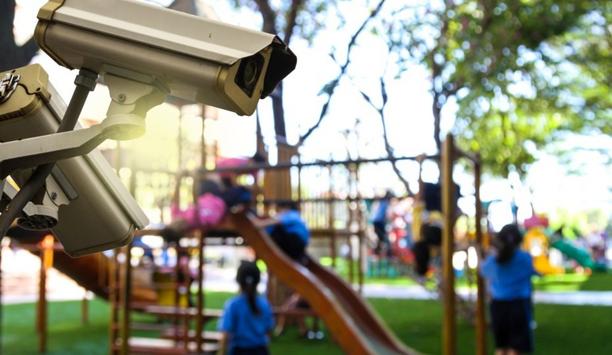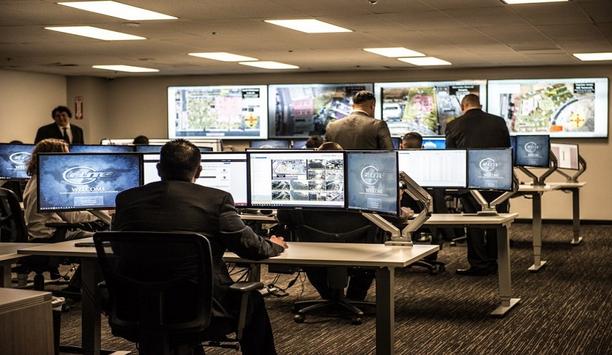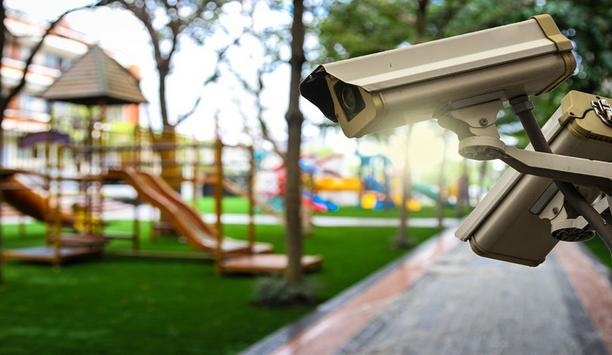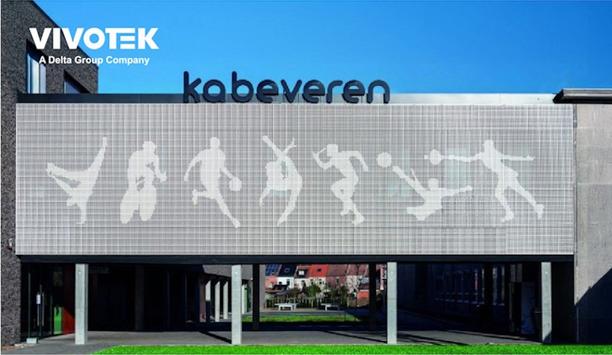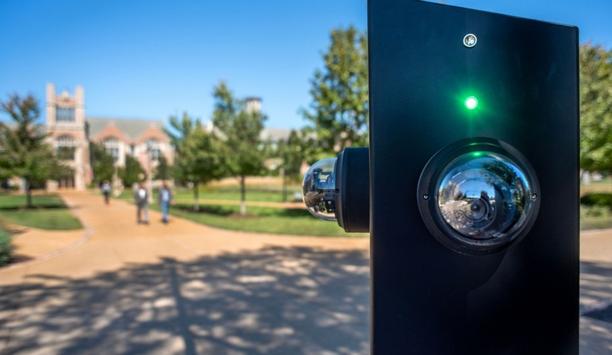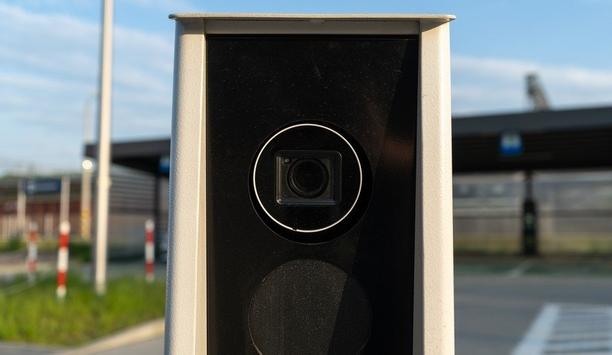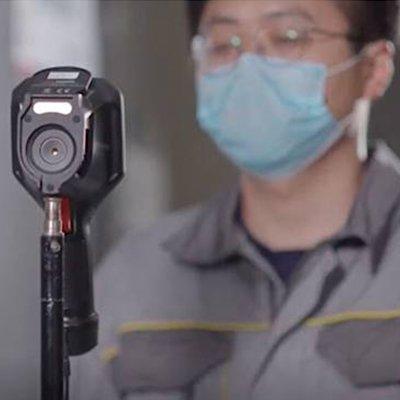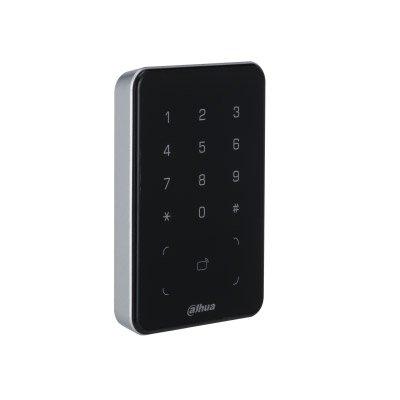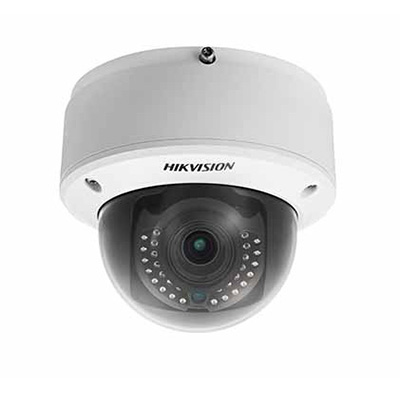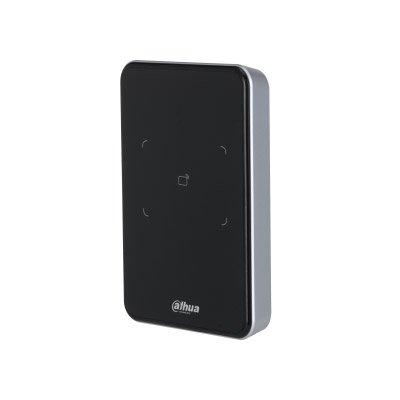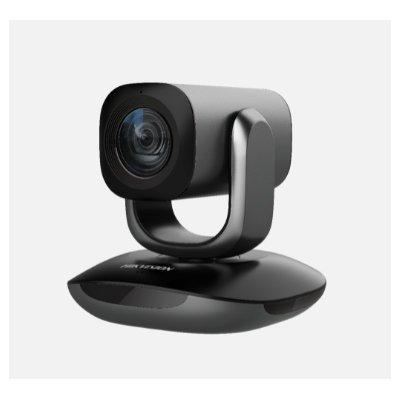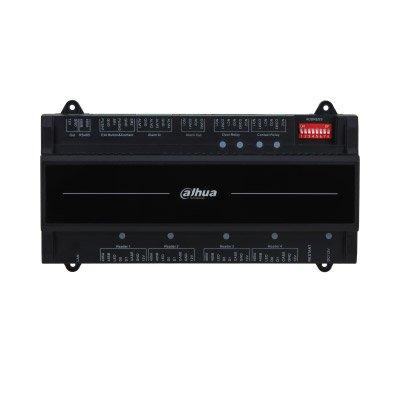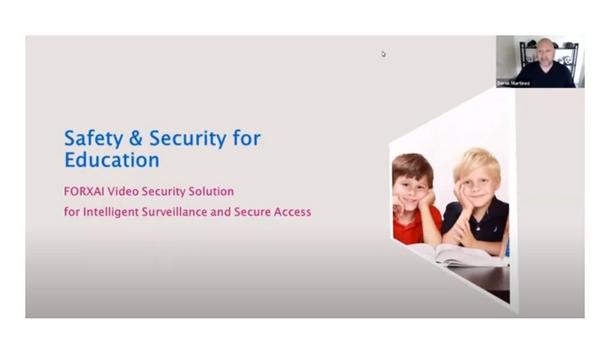School security
Fire and Security Apprenticeship Specialist, Skills for Security proudly marks the success of an inaugural Careers Fair, taking place near its Walsall training branch at The Bescot Stadium Locker Room. The event, designed to introduce local school leavers to career opportunities in the fire and security industry, welcomed an enthusiastic turnout of students, educators, and industry professionals. Fire and security sector The event provided a unique platform for students aged 14 to 18 to explo...
Eagle Eye Networks, the global pioneer in cloud video surveillance, launched Eagle Eye Automations. A flexible and extensible rules engine for automating tasks that empowers businesses to proactively and economically improve security, safety and business operations. Simplifying security management “Today’s security systems are complex, increasingly incorporating video surveillance, AI, analytics, sensors, and other third-party devices and technologies. Eagle Eye Automations enable...
Verkada, a pioneer in cloud-based physical security, opened nominations for its second-annual Safety Champion Awards. The awards recognise community leaders who work to keep people and places safe. The company will open nominations through July 16, 2025 across three award categories: impact, security professional excellence and school safety; and announce winners at its annual conference, VerkadaOne, this September. Dedication and commitment from safety "The dedication and commitmen...
dormakaba's upcoming EasyAssist™ low energy swing door operator makes entrances more accessible, convenient, and hygienic – with lower costs and time savings from planning to installation. dormakaba will preview EasyAssist at booth #20007 during the International Security Conference and Exposition (ISC) West 2025 in Las Vegas (March 31 - April 4). Operating modes and functions EasyAssist can be used in offices, medical practice buildings, hotels, retail stores, and schools Thanks...
Secure Schools has launched cyber score, a groundbreaking, free-to-use tool designed to help schools measure, benchmark, and improve their cybersecurity posture. Cyber score is designed to help schools benchmark, improve, and better protect against common cybersecurity threats by answering simple one-click statements to calculate their cyber score, built around pioneering cybersecurity standards. Cybersecurity challenges in education Cyber score addresses these challenges by offering a s...
Eagle Eye Networks, the pioneer in cloud video surveillance, launched Eagle Eye Sensors to detect and automatically alert when vaping, air quality changes, temperature shifts, water presence, and other environmental events occur, empowering schools and businesses to take immediate action to ensure building safety, efficiency, regulatory compliance, and healthy work and learning environments. Eagle Eye Cloud VMS Integrated into the Eagle Eye Cloud VMS (video management system), Eagle...
News
VIVOTEK, the pioneering security solution provider, has been committed to safeguarding communities and building a sustainable future since its founding in 2000. With "Care" as its core value, the company integrates cutting-edge security technologies to foster a safer and more sustainable world. Marking its 25th anniversary, VIVOTEK has unveiled its anniversary slogan, “MAKE TOMORROW EASIER, TODAY!” along with a refreshed brand identity, emphasising its focus on AI and cloud-driven solutions. Latest AI-powered security innovations VIVOTEK aims to simplify security by leveraging advanced technology, empowering customers VIVOTEK aims to simplify security by leveraging advanced technology, empowering customers to embrace a safer and more seamless future. As a key highlight of its 25th anniversary, VIVOTEK will showcase its latest AI-powered security innovations—integrated with the Vision Language Model—at ISC West 2025, the largest international security trade show in the U.S., this April, ushering in a new era of intelligent security solutions. Security industry's evolution "From a humble startup with fewer than 10 employees to a global enterprise with around 1,300 team members and a presence in over 100 countries, VIVOTEK has been at the forefront of the security industry's evolution—from analog to digital, IoT, cloud and AI." "With ‘Care’ as our driving force, we are dedicated to fulfilling the fundamental human need for security. Moving forward, we will continue to strengthen our AI and cloud capabilities, working hand in hand with our customers and partners to build a sustainable future," said VIVOTEK President Alex Liao. VIVOTEK’s experience vision VIVOTEK understands its customers' need for enhanced security efficiency To commemorate its 25th anniversary, VIVOTEK is launching a global campaign under the theme “MAKE TOMORROW EASIER, TODAY!” The company is also reviving its partner event —its first post-pandemic distributor gathering—bringing together hundreds of partners in Taiwan to experience VIVOTEK’s vision, explore key security technologies and discuss global market strategies. VIVOTEK understands its customers' need for enhanced security efficiency. It has integrated its full range of AI-powered cameras, AI-driven video analytics and AI-Powered cloud surveillance platform VORTEX into a hybrid cloud solution. VIVOTEK AI-driven solutions The number of connected VORTEX cameras has surpassed 10,000, enabling businesses to achieve greater efficiency, flexibility and security while maximising cost-effectiveness and security performance. Regarding vertical market strategy, VIVOTEK prioritises Smart Cities, Smart Transportation and Smart Manufacturing while also expanding into retail, education and sustainability sectors, bringing its AI-driven solutions to a global audience. VIVOTEK technological innovation and market expansion VIVOTEK remains committed to corporate social responsibility and sustainable development Beyond technological innovation and market expansion, VIVOTEK remains committed to corporate social responsibility and sustainable development. The company actively promotes green transformation and carbon reduction initiatives, develops energy-efficient products and strongly emphasises community engagement. VIVOTEK's smart security brand VIVOTEK has organised the “Safety Map Sustainability Event” for four consecutive years, enhancing local neighbourhoods, mental retardation training services institution, elementary school and historic village to improve community safety and environmental sustainability. With these efforts, VIVOTEK is paving its path toward becoming the world’s most trusted smart security brand.
i-PRO Americas Inc. (formerly Panasonic Security), a pioneering manufacturer of edge computing cameras for security and public safety, announced the launch of VideoInsight™ version 8.0, the latest release of its powerful video management system (VMS). Designed to meet the evolving security needs of school administrators, IT directors and security teams, VideoInsight 8.0 simplifies campus safety with an intuitive, cost-effective platform that delivers seamless integration, advanced AI tools and unmatched reliability. VideoInsight platform Educational institutions face ongoing challenges such as limited budgets, complex security infrastructures and fragmented security tools that hinder real-time response. The VideoInsight platform directly addresses budget concerns by not requiring camera licencing when using i-PRO cameras; this drives down upfront costs and lowers reoccurring costs. Intuitive dashboards and features VideoInsight 8.0 reduces administrative burdens, saving both time and resources With intuitive dashboards and automated maintenance features, VideoInsight 8.0 reduces administrative burdens, saving both time and resources. Built-in self-diagnostics, health monitoring and database optimisation ensure system reliability with 24/7 fault tolerance, minimising IT oversight and lowering maintenance costs, freeing up valuable resources for other critical school operations. It also offers cloud-based storage options without requiring additional middleware, allowing schools to reduce expensive hardware costs while maintaining easy access to video footage for investigations and compliance. Key benefits Scalable Security: VideoInsight 8.0 is designed to adapt to evolving security requirements in schools without adding complexity. Its open-platform design seamlessly integrates with i-PRO hardware and third-party solutions from Triton Ultra (vape detection), ZeroEyes (weapons detection), Wasabi (cloud storage), and Zenitel (video intercom), reducing upfront costs and long-term ownership expenses. Schools can integrate it effortlessly with existing systems while benefiting from cost-effective licencing and a future-ready security platform. Faster Forensic Searches with Built-In i-PRO Active Guard: i-PRO Active Guard is now natively integrated into the VideoInsight 8.0 platform, enabling forensic searches directly within the camera pane – eliminating the need for separate plugins. Schools can consolidate all security devices, including indoor, outdoor, and transportation cameras, into a single, user-friendly platform. i-PRO Active Guard extends across servers, clients, web and mobile platforms, enabling AI-triggered searches without switching between multiple applications. Unified Access Control and Video Management: VideoInsight 8.0 integrates seamlessly with i-PRO’s MonitorCast access control platform, creating a single-pane-of-glass view for access control events tied to video footage. This integration streamlines workflows, saving time and providing a comprehensive, real-time security overview. Whether on campus or off-site, security teams can monitor school security remotely with AI-triggered searches, instant alerts and mobile access, ensuring swift response to incidents. Enhanced Transit Solutions: VideoInsight 8.0 improves transit monitoring with native video offloading and durable storage technology, ensuring reliable video performance for buses and other school transportation systems—all within a single platform. Cost-Effective Body-Worn Camera Deployment: The i-PRO BWC4000 body-worn camera includes a bundled camera licence, allowing direct connectivity to VideoInsight 8.0 without additional licencing costs. Advanced accessible security solution “Our goal is to provide educational institutions with an advanced yet accessible security solution that provides an end-to-end offering with options for access control, vape and weapons detection, intercom, cloud storage and more,” said Adam Lowenstein, Product Director at i-PRO Americas, Inc. “VideoInsight 8.0 stands out by offering a unique combination of affordability, high-performance features and open infrastructure. Unlike other VMS solutions, it seamlessly integrates with existing hardware and software while reducing or even eliminating recurring licencing fees, ensuring institutions get maximum value without hidden expenses.”
ISS (Intelligent Security Systems), a pioneering provider of video intelligence and data awareness solutions, is excited to announce the appointment of Phil Jensen as its new Director of Sales for Under Vehicle Surveillance Systems (UVSS). Jensen brings a wealth of experience and expertise to ISS, particularly in government sales, technical security solutions, and growth-focused strategies. Prior to joining ISS, he held the position of Director of Government Business Development and Sales at Atmospheric Plasma Solutions, where he drove market expansion and fostered strategic partnerships in the government sector. Jensen leadership roles A 21-year U.S. Coast Guard veteran, Jensen is a proven pioneer with ample training in strategic operations Throughout his career, Jensen has held leadership roles at multiple organisations, including Advanced Detection Technology, SureID, Securewest International, and Lyon Workspace Products. A 21-year U.S. Coast Guard veteran, Jensen is a proven pioneer with extensive training in strategic operations. Alongside his military background, Phil holds a Master of Business Administration from Keller Graduate School of Management. His experience in delivering customer-focused solutions complements the ISS mission to revolutionise the market for AI-driven surveillance. Advanced security solutions "Joining ISS was an easy decision for me. The company’s commitment to innovation and delivering advanced security solutions will help us redefine the UVSS space across North America," said Jensen. "Phil’s expertise in key vertical markets, combined with his ability to foster customer success through innovative solutions, makes him an invaluable addition to the ISS team," said Matt Powell, Managing Director for North America at ISS. "His leadership will be instrumental in shaping the future of our Under Vehicle Surveillance Systems portfolio and driving our mission to provide cutting-edge security offerings." SecurOS® UVSS platform from ISS The UVSS provides critical insights to protect high-security venues, critical infrastructure The SecurOS® UVSS platform from ISS offers a compact, high-performance surveillance solution capable of scanning the undercarriage of vehicles to detect threats and other anomalies in as little as three seconds. Leveraging advanced analytics, including magnetic anomaly detection, 3D magnifying glass capabilities, and dewarping technology, the UVSS provides critical insights to protect high-security venues, critical infrastructure, and other sensitive locations. ISS’ dedicated mission A resident of Chesapeake, VA, and the father of two daughters, Jensen now joins ISS’ dedicated mission to provide impactful, AI-powered solutions for complex security challenges. His experience in establishing long-term government and industry partnerships will be critical in expanding the adoption of the award-winning UVSS technology throughout the security industry.
IDIS Americas will have a bigger presence at ISC West this year (April 2025, Las Vegas, booth #8037) with an expanded range of high-quality, Korean and U.S.-origin technologies and its most comprehensive lineup of new products and technologies to bolster its end-to-end, AI-enhanced video surveillance solutions. A major draw for visitors will be IDIS’s new Edge AI Camera Plus range which offers users a host of tools to improve real-time surveillance operations and footage search-and-playback. Updated IDLA Pro functions New range features updated IDLA Pro functions that drive even greater operational efficiency The new range features updated IDLA Pro functions that drive even greater operational efficiency for busy security teams, with on-the-edge analytics capabilities including crowd detection, abandoned and removed object detection, fall detection, and violence detection, enabling more proactive security responses. It also features the new A-Cut function, allowing searches by key attributes. Visitors to ISC West will get an exclusive first look at IDIS’s patented Live Privacy Masking technology, which allows more accurate, reliable, and responsive real-time video surveillance, while protecting individuals’ identities. Deep learning technology This important innovation uses deep learning technology to improve the quality and usability of privacy masked footage to assist live surveillance operations. Overcoming the limitations of existing technologies, this is an ideal solution for applications with privacy compliance concerns, from mass transit to public institutions. I-Mobile integrates AI-powered video surveillance IDIS will be showcasing a strong lineup of solutions for the education (K12) sector The I-Mobile solution for mass transit applications builds on IDIS’s 20-year track record pioneering video surveillance technology for transit services including private and public bus fleets. I-Mobile integrates robust AI-powered video surveillance and GPS with wider fleet management systems to optimise security, safety, operational agility, and profitability. IDIS will be showcasing a strong lineup of solutions for the education (K12) sector, including robust video intercoms for secure and efficient access control, and weapons detection surveillance powered by IDIS Vaidio AI analytics, a powerful AI solution which offers a broad range of highly accurate automated detection and alert functions. Latest AI functionality For retail applications, IDIS will showcase its comprehensive choice of video technologies proven to reduce losses and boost profitability. With the latest AI functionality, IDIS end-to-end solutions include the widest choice of cameras, recorders, and VMS to help retailers of all sizes – from high-end and luxury stores to grocery chains - enhance operational efficiency and improve their customer experience, while helping to ensure security. Range of NDAA-TAA compliant video solutions IDIS showcases a full range of NDAA-TAA compliant video solutions that meet FIPS 140-3 compliance Enabling easier systems integration, IDIS HDMI Encoders allow data from point-of-sale to be overlayed on high resolution video for ease of investigation, while log collectors can feed retail video analytics data into wider ERP and inventory management systems. For U.S. government applications, IDIS will showcase a full range of NDAA-TAA compliant video solutions that also meet FIPS 140-3 compliance. For the banking sector, IDIS’s best-selling video solutions for ATMs will be on display, including specialty cameras that integrate with IDIS Solution Suite VMS and are designed for robust performance in isolated and physically challenging environments. IDIS’s Hybrid TVR recorder (TR-2604) supports analog and IP cameras, featuring a compact design to fit inside ATMs. 5MP IR PoE Extender Cameras In the logistics sector, IDIS Americas has already made a significant impact with its award-winning fisheye cameras which provide cost-effective 180-degree surveillance of loading bays and storage areas without blind spots. At ISC West, the company will also showcase the 5MP IR PoE Extender Cameras that give easier, faster options for system expansion, leveraging existing wiring and eliminating the need for new cabling from the NVR or switch. IDIS Solution Suite VMS IDIS booth will feature hands-on Experience Zones giving visitors the chance to try out IDIS NVRs This year, the IDIS booth will feature hands-on Experience Zones giving visitors the chance to try out IDIS NVRs and receive valuable experience with the feature-rich, user-friendly IDIS Solution Suite VMS. Additionally, IDIS Americas is launching a new Partner Program, designed to empower systems integrators with exclusive advantages. Members will gain priority support, tailored training, and access to cutting-edge security solutions that drive growth and success. Advanced lineup of end-to-end video solutions The program ensures integrators have the resources and expertise needed to deliver seamless, high-performance deployments across a range of industries. “This year at ISC West, IDIS Americas is making a bigger impact than ever before,” said Scott Switzer, CEO of IDIS Americas. “We’re bringing our most advanced lineup of end-to-end video solutions, packed with game-changing AI, smarter integrations, and industry-first innovations." IDIS Vaidio AI analytics The program ensures integrators have the help and expertise needed to deliver seamless solutions Switzer added: "From our Edge AI Camera Plus range and next-gen IDIS Vaidio AI analytics to cutting-edge privacy masking and seamless enterprise integrations, we’re delivering the technology our customers need to enhance their security, boost efficiency, and help drive profitability." "We’re also investing in our commitment to integrators with the launch of our new Partner Program giving them the tools, training, and support to win more business and deliver outstanding results. This is the year to experience IDIS like never before, and we are excited to show ISC West attendees what’s next.” How IDIS solutions simplify installation and operation Visitors to the IDIS booth at ISC West can expect an unforgettable experience, gaining firsthand insight into the power of IDIS end-to-end video solutions. They’ll connect with the experts behind the technology, explore industry-pioneering innovations that deliver unmatched recording stability and reduced storage burdens, and discover tools for more proactive, real-time monitoring. Attendees will also see how IDIS solutions simplify installation and daily operation, lower maintenance and operating costs, and enhance cybersecurity with proprietary protocols and certificate-based authentication.
Aryaka®, the pioneer in and first to deliver Unified SASE as a Service, announced a significant GTM investment across the Asia Pacific region as well as new GTM executives globally. As part of the expansion, Aryaka has added new partnerships with NI+C in Japan and ASV Platforms in Australia to further their sales reach in these countries. Several key leadership roles The company has hired several key leadership roles, including Vice President of Global Channels In addition, the company has hired several key leadership roles, including Vice President of Global Channels, Nick Alagna, and Vice President and General Manager of Asia Pacific, Nitin Ahuja, as well as adding William Ho as a strategic advisor in the Asia Pacific Region. “This announcement is just the beginning of our investment in new partnerships and routes to market for Aryaka,” said Chris Ranalli, Chief Revenue Officer at Aryaka. “With the hiring of Nick, Nitin and others, we are building a world class team, accelerating our success through both experience and relationships.” Aryaka leadership team to guide GTM ramp-up Aryaka has added several key executives to accelerate its GTM efforts. Nick Alagna joins Aryaka with over 20 years of experience driving significant growth for pioneering technology companies and startups. As Global Channel Chief, Alagna will lead the charge in building and scaling Aryaka’s global channel ecosystem, empowering partners to deliver customer value with Aryaka’s Unified SASE solutions. His expertise spans global go-to-market strategies and partner ecosystem development for cutting-edge solutions in cybersecurity and cloud technologies. Prior roles of Nick Alagna co-founded WholeSecurity, a venture-backed cybersecurity startup by Symantec Previously, Nick led Channel Sales and Strategic Partners at Akamai Technologies, where he was responsible for Akamai’s strategic partner ecosystem. His leadership resulted in highly profitable businesses for partners, significant year-over-year growth for Akamai, and increased value for customers. Earlier in his career, Alagna co-founded WholeSecurity, a venture-backed cybersecurity startup acquired by Symantec. Secure networking journeys “I am beyond excited to join Aryaka at this critical time in its evolution,” said Alagna. “It is rare to find an organisation who has demonstrated both channel commitment and product leadership in a growing and robust market." "The opportunity for our partners worldwide is extraordinary, and I am thrilled to enable and support our partners to scale their businesses by helping more and more customers succeed on their secure networking journeys.” Data and application security Nitin Ahuja also brings over two decades of business and technology experience to Aryaka Nitin Ahuja also brings over two decades of business and technology experience to Aryaka. As Vice President and General Manager of APAC/APJ, Ahuja will lead all GTM functions in the Asia Pacific region. He previously served as a sales and GTM executive across APAC markets at Imperva, a pioneer in data and application security. Before that, he worked in regional leadership positions at VMWare, HPE and Microsoft. Integrated secure networking experience “Aryaka has made this region a strategic priority and this expansion proves it. The company is poised for major growth here, backed by new partners, pioneers and dedicated resources in the region,” said Nitin Ahuja, Vice President and General Manager of APAC / APJ at Aryaka. “Working closely with our partners, we’ll help more organisations across the region experience an integrated secure networking experience without any tradeoffs.” Strategic investment and expansion of Aryaka Ahuja and Ho will guide and drive the strategic asset and growth of Aryaka in the region In addition to Ahuja, Aryaka also announced that William Ho, former CEO of Hong Kong Broadband Enterprise Solutions and adjunct professor at the University of Minnesota - Carlson School of Management, as a strategic advisor in the Asia Pacific region. Together, Ahuja and Ho will guide and drive the strategic investment and expansion of Aryaka in the region. Other key go-to-market executives Aryaka has added several other key go-to-market executives across the globe, including: Mike Ellis, Channel Sales Director, EMEA Elad Tzur, Channel Sales Director EMEA Meng Foo, Channel Sales Director, ASEAN Abhijit Neelgar, Channel Sales Director, India Aryaka forges critical partnerships in Asia Pacific Aryaka has entered into a new partnership with Nippon Information and Communication (NI+C) to bring the benefits of fully integrated networking and security to organisations across Japan. Founded by NTT and IBM Japan in 1985, NI+C is a pioneering network-systems-integrator. The company has helped over 2,600 customers manage and build IT environments that support long-term business growth. Aryaka partnership with ASV Platforms ASV Platforms designs and delivers cutting-edge cloud-first software and cybersecurity solutions Aryaka has also announced a partnership with ASV Platforms, a premium strategic partner for Aryaka across Australia and New Zealand. ASV Platforms designs and delivers cutting-edge cloud-first software and cybersecurity solutions in the Australian and New Zealand markets to help their global customers ensure high performing secure networks. Together, the two will deliver Aryaka’s Unified SASE as a Service offering to both enterprises and governments in the region. Aryaka premium strategic partner “Being the Aryaka premium strategic partner in Australia and New Zealand will allow us to bring their market pioneering Unified SASE as a Service solution technology to the Australian market, helping businesses achieve unparalleled network performance, agility, and security." "Our extensive C-level expertise and understanding of the unique needs of Australian companies position us perfectly for this collaboration," Ian Woollett, Chairman, ASV Platforms. Aryaka beefs up GTM programs As part of the growth, Aryaka has invested greatly in regional GTM programs As part of the expansion, Aryaka has invested significantly in regional GTM programs. With over 100 customers in the Asia Pacific region including Cathay Pacific Airlines and others, the company is committing more investment in go to market partners leadership, personnel and programs in the APJ region and globally, introducing their Unified SASE as a Service solution to the next wave of customers. Market efforts Ranalli summed up the announcement, “We have the right product, the commitment to the channel, amazing partners and now the team in place to scale our go to market efforts not only in Asia Pacific, but in our existing markets worldwide." "It’s go time, and the team is both equipped and energised to win!”
Rhombus, a pioneer in cloud-managed physical security, announced the acquisition of Dashdive, a SaaS platform specialising in monitoring and analysing multi-tenant cloud service costs. The acquisition enables Rhombus to optimise cloud expenses and deliver more cost-effective solutions to its global, cross-industry customer base. Integrate Dashdive’s capabilities Rhombus had been using Dashdive’s technology to gain deeper insights into its cloud costs Rhombus had been using Dashdive’s technology to gain deeper insights into its cloud costs on a per-camera and per-customer basis. This acquisition allows Rhombus to fully integrate Dashdive’s powerful cost management capabilities into its operations, supporting the company’s mission to deliver enterprise-grade cloud-based camera, sensor, access control, and alarm monitoring systems at competitive price points. Cloud infrastructure costs “As we’ve scaled to more than 50,000 locations worldwide, understanding our cloud infrastructure costs at a granular level becomes increasingly critical,” said Brandon Salzberg, VP of Engineering. “Dashdive has already played a critical role helping us optimise cloud expenses. By bringing the technology in-house with this acquisition, we’re strengthening our operational efficiency and passing those benefits on to our customers through more competitive pricing and enhanced service delivery.” Multi-tenant cloud costs Dashdive, a Y-Combinator-backed company, developed sophisticated tools that break down multi-tenant cloud costs by feature—providing organisations with deep visibility into their cloud spending. “Joining forces with Rhombus is the perfect next step for Dashdive,” said Adam Shugar, CTO and co-founder of Dashdive. “Seeing how Rhombus has leveraged our platform to enhance their services validates our vision, and we’re excited to continue this journey as part of the Rhombus team.” Rhombus’ cloud-based approach Rhombus’ cloud-based approach to physical security has already modernised legacy The acquisition comes at a time of significant growth for Rhombus, which serves over 3,000 customers—from school districts to manufacturers to Fortune 500 enterprises. Rhombus’ cloud-based approach to physical security has already modernised legacy and inflexible physical security systems. Addition of Dashdive’s expertise With the addition of Dashdive’s expertise in cloud cost management, Rhombus is positioned to further accelerate innovation while maintaining its commitment to providing scalable, future-proof solutions. The Dashdive team will join Rhombus, ensuring continuity and expertise as the companies integrate their technologies.


Expert commentary
In the past, security and IT teams operated independently, but today collaboration is critical. Modern security systems rely on various devices and systems that are linked to internal and external networks. Without IT involvement, physical security can become a weak point for cybersecurity. Although these groups have made headway in partnering up to ensure the successful implementation of new solutions, often there’s still a disconnect. Differing skills, priorities, and unique ways of thinking have contributed to siloed ways of working. Unified security technologies Thankfully, solutions do exist to help improve coordination between teams and departments Other factors can also make collaboration more difficult. Budget limitations and staff turnover may result in a lack of specialised security training among operators, who don’t know which stakeholders to engage or when. Staff may be willing to collaborate, but do they know who should be alerted when there’s an event? If everyone is alerted to everything, those who don’t need that information will eventually start to tune out. Thankfully, solutions do exist to help improve coordination between teams and departments. Unified security technologies can enhance collaboration, streamline communication, and improve response times. This enables cross-functional teams to respond faster, make better decisions, and work together to enhance overall security. IT and physical security teams Physical security teams are experts at identifying and mitigating physical threats to the organisation. IT teams know the ins and outs of keeping systems and networks secure. Both roles and skill sets are critical to securing the enterprise, but siloed operations create barriers to effective collaboration. Because IT and physical security teams have different mandates, meeting the needs of both can be tricky. In some organisations, different departments or specialties also have their own reporting structure and may have different ways of working. Silos may even exist within departments. Overcoming challenges to collaboration Addressing these challenges is the first step toward improving collaboration For example, floor security, dispatchers, investigators, and loss prevention specialists may be used to operating independently in their day-to-day routines. They may not always share data or involve each other in decision-making. Pioneers of these departments are used to being in charge of their domains and may resist initiatives that appear to threaten this independence. Addressing these challenges is the first step toward improving collaboration. Organisations need effective tools to filter out the noise and ensure that the right people get the information that’s relevant to them every time. There are tools available to help teams collaborate effectively, stay accountable for completing tasks, and keep track of what’s been done while maintaining departmental goals and objectives. The right technology can help break down silos The first step to improve collaboration is to break down silos between your security systems. Choosing a unified security platform creates a solid foundation for cross-functional collaboration. It ensures that your physical security and IT teams are reading from the same database. Everyone can see potential risks across both digital systems and physical sites. Unified security solutions centralise monitoring, alarm management, and reporting in a single interface. This helps security teams manage incidents, run investigations, and oversee all security policies. Risks of real-time cybersecurity Data from security systems can be useful to analyse and improve operations and customer experience Within the same platform, IT experts can have a comprehensive view of real-time cybersecurity risks. They can also implement a single data protection and privacy strategy across all locations. Built-in cybersecurity tools help to standardise encryptions, multi-factor authentications, user privileges, and more across the enterprise. In many organisations, colleagues from other departments also find great value in having access to this information. Data from security systems can be useful to analyse and improve operations, customer experience, facilities management, and more. There are many ways to collaborate using a unified security system. Depending on your goals and operating procedures, you have different ways to go about it. The starting point is always to simply get everyone on the same page. Leveraging technology for more effective collaboration A unified security software platform can not only manage your video surveillance, access control, automatic licence plate recognition (ALPR), and other physical security systems, but also data from many other kinds of IoT devices and databases. The volume of data is immense, but thankfully these systems can offer ways to filter out the noise and keep operators focused on the most relevant data for their work. Being able to quickly gather, analyse, and share data with other team members can make or break an emergency response. In one case, an attack at a convention centre was thwarted after a team member monitoring social media mentions of an event noticed threats published online. When security operators were alerted, they were able to use video analytics to identify the suspect at the event. Using a unified security platform, the operators were able to send the camera view to other team members near the suspect. In the end, they were able to stop the attack through multi-departmental collaboration. Right security platform The right security platform can also help you drive more effective and proactive operational decision-making The right security platform can also help you drive more effective and proactive operational decision-making. When bringing datasets from disparate systems together, it's easier to discover relationships and make changes to business operations. For example, in a retail environment, combining access control, heat maps, and point of sale (POS) data can provide insights into customer activity. This kind of data may be used for things like loss prevention, but it can also be helpful to improve customer experience by improving traffic flow or directing staff toward the busiest areas of the store. The importance of automation One of the most important ways a unified security platform can optimise operations and encourage collaboration is to leverage automation to prioritise and triage alerts. This reduces false alarms and streamlines emergency responses. The reality today is that security operators aren’t always specialists. In K-12 school campuses, for example, the person monitoring the system is often an administrator or teacher. A non-specialist operator may be comfortable using the system in their day-to-day routine, but what about when the unexpected happens? If they don’t know what to do in an emergency, precious time may be wasted while they look up written instructions or call a colleague to help. Instead of keeping your SOPs in a paper binder, you can digitise them so that your security platform guides operators. They immediately have the steps to follow in an emergency. The system can even automatically alert internal or external stakeholders if certain conditions are met. Pros of automation Automation may also reduce false alarms. Nuisance alerts are a real problem for many organisations because they pull resources away from important tasks. When there are many false alarms, operators can also become desensitised to them, which slows response in a real emergency. Nuisance alerts are a real issue for many corps because they pull help away from vital tasks There are several ways that a unified security platform reduces false alarms. When data from multiple systems is brought into the same platform, a door-forced-open event can be cross-referenced with footage from nearby cameras or motion sensors. The system is programmed to do this automatically and issue a priority alert if there’s both a door forced open and motion detected in a restricted zone. Or, when a door open alert happens, the system can direct operators to first check nearby cameras and then decide whether or not to send a security guard to investigate. Every organisation is unique and automations will reflect that. Stadiums or public transit may want to automate notifications to stakeholders’ phones, change the message on a digital marquee, or broadcast a public announcement when there’s something to communicate. In a school context, perhaps there is a panic button under the front desk, which triggers a threat alert. When the button is pressed, all classroom doors are locked from the outside. Teachers can get a text message notification warning them about the threat, and local police are alerted instantly. Practical steps for building a collaborative security environment As exciting as it can be to explore the possibilities of new technologies, it’s important to have realistic expectations. Start with small steps and simplify as much as possible. Operators require time and training to adapt to new systems, and teams that have been working independently may need time to develop rapport and trust with each other. When adopting new technologies, a phased approach is often best to avoid overwhelming staff. If staff are resistant to change, focus on understanding their perspective: what are they trying to accomplish? What motivates them? What are they afraid of? Once you understand what’s driving their objections, you can come up with solutions to work through concerns. In today's rapidly evolving security landscape, fostering collaboration between physical security and IT teams is no longer a luxury—it's a necessity. By breaking down silos, leveraging integrated security technologies, and embracing data-driven decision-making, organisations can significantly enhance their operational efficiency and response capabilities.
For K12 education pioneers, embarking on a journey to upgrade security controls can present a myriad of questions about finding the best-fit solutions and overcoming funding hurdles. A majority of public-school districts today are faced with outdated infrastructure and security controls, requiring necessary upgrades. By addressing these concerns head on, schools will ensure a safer environment for both students and staff, mitigating risks posed by unforeseen physical and digital threats. Common K12 security pain points There’s no one-size-fits-all solution in school district security. School districts may have big plans to implement upgraded security systems but to set out on the right foot, pioneers must have a clear vision of their long-term strategy. When embarking on their security journey, education pioneers often wonder where to start and what exact steps are they need to be taking to identify and address weaknesses. Local K12 and government pioneers are promoting and mandating security assessments to uncover safety gaps on campuses and mitigate these risks with advanced technology solutions. Not only do assessments provide detailed, customisable roadmaps for district pioneers, but they also recommend technologies and funding opportunities to help close threat gaps. K12 school districts are mainly vulnerable to cyber-attacks due to the sensitive nature of student records In today’s climate, schools face a growing number of physical and digital security threats. From a cybersecurity standpoint, K12 school districts are particularly vulnerable to cyber-attacks due to the sensitive nature of student records. However, only one-third of these districts have adequate staffing to address threats effectively. In addition, according to a recent survey from Johnson Controls and Forrester Consulting, security decision-makers are having trouble receiving actionable insights. Nearly two-thirds of respondents said that they struggle to receive information from all necessary systems regarding their security threats. To gain more clarity into what school districts need in terms of security tools and threat mitigation, implementing system-wide monitoring and optimisation can be invaluable. This approach enhances equipment and operational efficiency, while providing necessary resources and expertise for critical patch updates across all systems, strengthening their overall security posture. Achieving a well-rounded security program In the past few years, AI technology has emerged as a trending solution and is generating considerable attention. While the allure of implementing cutting-edge technologies is undeniable, it’s important to recognise that a robust security program hinges on solid access control. Access control technology provides administrators with the means to oversee and regulate entry into facilities, serving as the foundation for basic physical security. The technology helps administrators and staff control access to multiple areas from web-enabled devices, even during lockdowns which is crucial in emergency situations. School district pioneers should utilise available digital risk assessment tools to uncover threat areas Once basic security controls are in place, school districts must address their next set of security pain points and identify which solutions meet their specific needs. This involves identifying and prioritising the highest need and most cost-effective investments that will have the greatest impact on enhancing security measures. To accurately determine which security solutions are needed for a specific environment, school district pioneers should utilise available digital risk assessment tools to uncover threat areas and determine levels of priority. By focusing on these priority areas, districts can allocate their resources and efforts where they are needed most, ensuring maximum effectiveness in mitigating risks and vulnerabilities. Securing funding before approaching deadlines A major challenge for school districts surrounding campus security is identifying and securing the necessary funding to implement solutions aligned with their goals. Leveraging available funding sources is critical, especially considering certain programs are approaching their deadline, like the Elementary and Secondary School Emergency Relief (ESSER) fund. Announced during the pandemic, ESSER is a funding program that has allocated nearly $190 billion in aid to U.S. public school districts to fund projects benefitting the well-being of occupants. Notable ESSER funding deadlines to keep in mind as the clock winds down include September 30, 2024 Notable ESSER funding deadlines to keep in mind as the clock winds down include September 30, 2024, when schools must attribute all of their funds to assigned contracts. Following this date, pioneers will need to complete all ESSER spending by January 2025 unless approved for an extension into March 2025. As ESSER wanes, school districts are acutely aware of the fiscal cliff in budgets through 2025. However, many states are ramping up grant funding to close the deficit gap. Administrators should become familiar with these grant opportunities at a local and state level. Get started on security plans The time for school district pioneers to act is now. While the safety and well-being of students and staff are always top priorities, it’s crucial to acknowledge that a lack of insight into necessary security upgrades and available funding options will leave districts behind the curve. Seizing the final months of ESSER funding presents an ideal window to address security pain points and build a safer future for K12 facilities. Looking beyond ESSER, pioneers must proactively seek out and leverage other funding avenues to help ensure the continuity of their security efforts and maintain a proactive stance in safeguarding healthy and safe educational environments.
The average business owner or investor has some kind of security precaution in place, especially in the after-hours when there are fewer deterrents to inhibit criminal activity. Security guards, video surveillance systems, motion sensor lights, or even just fake cameras placed around the property are some of the common options people choose. Future of overnight security Smart business owners are starting to realise, however, that some of these traditional security measures are becoming antiquated and no longer cutting. The now and future of overnight security is in remote guarding. Pioneered by companies like Los Angeles-based Elite Interactive Solutions, which was founded back in 2007, remote guarding is revolutionising the overnight security business. Minimising criminal activity Remote guarding is fast becoming the most popular choice among commercial end-user property owners Remote guarding utilises a combination of cutting-edge technology, “digital guards,” highly trained security agents, and local law enforcement if and when necessary to minimise the potential of criminal activity. For those adequately enlightened to its overwhelmingly impressive crime prevention capabilities, remote guarding is fast becoming the most popular choice among commercial end-user property owners to secure and protect their investments. What Is remote guarding? Remote guarding is a revolutionary concept and increasing trend in security systems that utilises a combination of methods to effectively analyse potential threats to property. Cameras and/or other monitoring devices running highly advanced algorithmic software are installed in strategic areas or vulnerable places onsite and remotely located security agents are immediately notified of any activity within a designated perimeter of the property. A blend of AI, cybersecurity, and video analytics When properly deployed by an expert provider, the technology stack includes a proprietary blend of video analytics, artificial intelligence, cybersecurity, and more. Done right, “noise” is effectively filtered out, allowing agents to act on legitimate alerts and achieve zero false alarms communicated to first responders. Today, there are a lot of terms and descriptions tossed around about remote guarding, remote video, virtual guarding, etc., but those attributes must be present to represent the true definition of the offering and its many virtues. Realtime situational awareness Many systems have a two-way speaker that allows the security agent to give a verbal warning When specially trained security agents are alerted to trespassers, possible intruders, or other suspicious activity, they analyse the situation in real-time and determine the necessary level of action. Many systems have a two-way speaker that allows the security agent to give a verbal warning, known as a voice-down, to the individual(s) that they are being watched. Most perpetrators, often believing the response is emanating directly from security personnel on the property itself rather than from a remote command centre, flee immediately. However, if the threat persists, the security agent enlists local law enforcement to get on the scene. Customised remote guarding When properly deployed, remote guarding systems are also customised to specific properties. A team of consultants visits the client’s property to evaluate its vulnerabilities and where to best place cameras and/or other monitoring devices for system efficacy. Traditional security shortfalls According to Keith Bushey, a retired commander for the Los Angeles Police Department, there is much frustration between law enforcement officers and potential victims of crime due to the historically unreliable performance of traditional burglar alarm systems and central monitoring stations. He states about 90% of security-related calls are false alarms, a problem that has been well-documented through the years. Onsite challenges When a legitimate emergency does occur, the perpetrators have often already done their damage When a legitimate emergency does occur, the perpetrators have often already done their damage and/or escaped by the time law enforcement arrives. Onsite security guards are not the remedy either as they bring their own set of issues and challenges. Unexpected costs Traditional security systems can also have unexpected costs. The cost is not only in the security guards’ paycheck or the cost of the equipment itself. The cost comes when an actual incident occurs. In worst-case scenarios, the security guard(s) are injured, the business suffers inventory loss, and/or damage is sustained to the property. The medical and other costs for the security guard(s), the loss of inventory, property damage, deployment of law enforcement resources, and possible fallout of legal expenses all add up. Even in the best-case scenario, false alarm expenses incur if law enforcement is dispatched. These, among many others, are some of the primary issues that remote guarding resoundingly answers as a superior alternative. A bounty of benefits Remote guarding systems have been proven to cut costs and be more effective than traditional security systems. Even though the monthly monitoring costs of remote guarding are significantly higher than traditional intrusion detection system monitoring, the much higher effectiveness in crime reduction, elimination of false alarms, and augmenting or replacement of manned guards result in a substantially higher return on investment (ROI) to the end user. Easy tracking of threats The security cameras already have their image captured on record, making them easier to track down For example, case studies have demonstrated reduced security costs for clients by 60%, on average. These reductions have come from the costs of security staff, inventory, or property loss, plus saving money on insurance premiums and deductibles. The nature of remote guarding reduces the risk and costs of false alarms, with professional security agents able to determine an actual threat before law enforcement is called. In a rare instance when a perpetrator escapes before law enforcement arrives or can detain the individual(s), the security cameras already have their image captured on record, making them easier to track down and identify. Reduction of false alarms The significant reduction in false alarms is greatly appreciated by law enforcement, as it allows them to focus on real emergencies or crises. Better relationships are also developed between clients and law enforcement, as remote guarding systems are highly reliable in providing accurate and real-time information to officers as they approach the scene. In short, it assists law enforcement in doing their job more effectively, as well as more safely thanks to having eyewitness information before engaging in an active crime scene. Partnership When you combine the decreased cost with the increased efficiency and success rate, it is easy to see why many commercial end-user property owners across the country are making the shift to remote guarding. It’s also an outstanding opportunity for professional security dealers and integrators to partner with a remote guarding services provider to bring a superior solution to their end customers and pick up a recurring monthly revenue stream in the process.
Security beat
The practice of executive protection changed forever on Dec. 4, 2024, when UnitedHealthcare CEO Brian Thompson was shot outside a Manhattan, New York, hotel. The shocking event raised awareness in board rooms around the world about the need for, and challenges of, executive protection. Questions followed immediately, including why was the high-level executive not protected? Combination of risk and reward UnitedHealthcare’s stock price has gone down more than 20% since the shooting The event also highlighted what is at stake for companies, extending beyond the safety of executives and impacting many factors, even including a company’s stock price. UnitedHealthcare’s stock price has gone down more than 20% since the shooting, equating to tens of billions of dollars. “Companies are considering the combination of risk and reward like never before when it comes to executive protection,” says Glen Kucera, President of Allied Universal Enhanced Protection Services. “What are the chances this could happen? Before Dec. 4 many thought it was zero. And what are the financial implications for a company if it happens? Executive protection is a small investment to protect against a worst-case scenario.” Evaluation of an executive protection Before the UnitedHealthcare shooting raised awareness, fewer than 50% of executives had protection. But concerns that previously fell on deaf ears now have the full attention of companies, says Kucera. “Boards of directors are having to figure this out,” he adds. “They may not have executive protection, but now they have to do it.” A threat assessment, conducted by a company such as Allied Universal, provides an independent evaluation of a company’s executive protection needs. The assessment evaluates factors such as an executive’s travel habits, the safety of their home, etc. Does the executive need protection 24/7, or just when they travel into more dangerous areas? Risks increase related to corporate earnings Sometimes, cases increase the need for executive protection, such as an internal threat In assessing threats, security professionals also look beyond the individual to consider the safety of a corporate facility, for example. “Is there a visual deterrent, controlling who comes and goes?” asks Kucera. “If there is good security, it all ties together. We do home assessment, facility assessment, route assessment, and travel assessment as needed.” Sometimes, circumstances increase the need for executive protection, such as an internal threat. Timing is a factor, and risks increase related to corporate earnings releases, new product announcements, and corporate layoffs or consolidation. Monitoring social media tracks shifting threats that impact the need for executive protection. UnitedHealthcare shooting “He didn’t have it and probably didn’t think he needed it,” comments Kucera about the UnitedHealthcare executive who was gunned down in the streets of New York City. “He was staying at the hotel across the street and was used to walking down the street every day.” “Sometimes executives want to preserve their privacy and be able to walk down the street,” says Kucera. “Getting protection can be seen as a sign of weakness. Some CEOs in the past have said they just didn’t want it.” However, the UnitedHealthcare shooting raised the stakes of the need for more vigilance. “The bottom line is you have to yet beyond objections and make the investment to protect against a worst-case scenario,” says Kucera. Anti-capitalist sentiment in the general population An internal police bulletin warned of an online hit list naming eight executives and their salaries Threats to executives sometimes arise from anti-capitalist sentiment in the general population about perceived inequalities in wealth and power. Executives provide symbolic targets for anyone who fights the system, and social media has amplified the voices of those who oppose capitalism. For example, a "Most Wanted CEO” card deck seeks to shine a spotlight on "titans of greed." Also, in the aftermath of the UnitedHealthcare shooting, CEO "wanted" posters appeared across New York City, threatening various executives of large companies. An internal police bulletin warned of an online hit list naming eight executives and their salaries. Careful monitoring of social media posts Careful monitoring of social media posts and other sources enables executive protection professionals to analyse data and separate the dangerous threats from the merely negative ones. Sadly, positive support of the UnitedHealthcare shooting was expressed by the 300,000 or so followers of the shooter, who became a celebrity of sorts. A huge outcry of negative sentiment toward the insurance industry led to fear that copycat incidents might occur. “There has been an unprecedented amount of positive support for committing murder,” commented Kucera. Executive protection requests HR executives can be at risk, especially at a time of layoffs or consolidation “Let’s face it, there has been a lot of controversy, from COVID to the Middle East crisis, to the political campaign, and there is negativity on both sides,” says Kucera. “People have opportunities to pick sides, and there is a lot of sentiment going both ways, and there is a small percentage of people who will act aggressively.” Executive protection requests now extend beyond the CEO to include others in the management ranks of companies. Basically, any public-facing executive is at risk, including anyone who makes statements to the press. Human resource (HR) executives can be at risk, especially at a time of layoffs or consolidation. Private information on the Internet Typically, an executive is assigned a single armed operative for protection. The firearm serves primarily as a visual deterrent that hopefully makes a potential perpetrator think twice. “When they plan an event like this, their expectation is that it will be a soft target,” says Kucera. “If there is an officer, it gives them pause.” Controversial or high-profile CEOs are typically protected 24/7, including when they travel with their family. Adding risks is the fact that private information is now posted on the Internet, including where an executive lives and where their children go to school. Internet monitoring Internet monitoring also includes the “dark web,” which includes sometimes dangerous information “We offer social media monitoring, and we advise them to be more careful with what they post,” says Kucera. “We monitor reactions to posts including any that might be threatening. We watch social media carefully if a company announces earnings or a change in their service or product offering.” Internet monitoring also includes the “dark web,” which includes sometimes dangerous information that is intentionally hidden and requires specific software, configurations, or authorisation to access. Own layer of protection Public and government officials can also come under fire in a variety of scenarios. FEMA officials faced threats after the recent floods in the Southeast, for example, among other situations where perceived unfair treatment promotes thoughts of retribution. Although government agencies have their own layer of protection, there are instances when they call on companies such as Allied Universal for additional help. Ad hoc protection for various executives In the aftermath of the UnitedHealthcare shooting, calls to Allied Universal’s Command Centre increased by 600%, reflecting requests for ad hoc protection for various executives. These requests are in addition to the company’s business providing “embedded” operatives that travel with executives all or some of the time. On that side of the business, requests for services are up probably 300%, says Kucera. {##Poll1742194323 - Has the recent increase in violent threats changed your company's view on executive protection?##}
An attention-grabbing exhibit at GSX 2024 in Orlando involved a robot dog that could open a door. Boston Dynamics robot dog ASSA ABLOY impressed attendees with the robotics demonstration, featuring the Boston Dynamics robot dog that could open a door using either an HID credential or a mechanical grip. This innovation represents a shift toward more autonomous security solutions and is suitable for environments where human access may be limited. ASSA ABLOY impressed attendees with the Boston Dynamics robot dog Operational efficiency Eye-catching exhibits at the GSX in Orlando, showcasing the future of security technology It was one of many eye-catching exhibits at the GSX in Orlando, showcasing the future of security technology, and offering practical solutions to the industry's challenges. For security professionals, the advancements presented opportunities to enhance operational efficiency and to maintain a proactive stance in a rapidly evolving market. Control ID face identification Alongside their robot demonstration, ASSA ABLOY also highlighted the Control ID Face Identification. Access Controller, providing advanced facial recognition access control. From identity management to AI-driven surveillance systems, GSX 2024 offered a glimpse into the tools that can streamline processes, increase security, and reduce costs. Here are some other highlights. ASSA ABLOY also highlighted the Control ID Face Identification More integration with critical infrastructure A major theme at GSX 2024 was the increasing integration of security solutions with critical infrastructure. ALCEA (formerly ASSA ABLOY Critical Infrastructure) is an example. Their globalised software solution ALWIN is designed for managing access control, visitor management, and other security factors across multiple locations. ALCEA's approach involves not only internal collaborations within ASSA ABLOY but also partnerships with external organisations. An example of innovation is the Neenah Foundry lockable manhole cover, blending safety and security. Solving identity management challenges The solution simplifies onboarding and access request changes while ensuring compliance with policies Identity management continues to be a key focus in the security sector, and AMAG Technology addresses this need with its Symmetry Connect product. The solution simplifies onboarding and access request changes while ensuring compliance with policies. For professionals overseeing identity access management, Symmetry Connect provides a streamlined, automated approach, reducing human error and increasing operational efficiency. AMAG also sees a growing demand for efficient visitor management systems, especially in the post-COVID landscape. AMAG’s products cater to the need for enhanced security without overburdening staff. AI and cloud-based surveillance solutions Axis Communications highlighted its advancements in AI and cloud-based video management systems with its AXIS Camera Station Edge and Pro products. These solutions can connect seamlessly to cloud systems, providing security professionals with easy access to surveillance data anywhere. With the increasing need for centralised management, Axis’s offerings ensure that security teams can efficiently manage surveillance with minimal infrastructure. Axis also showcased its commitment to AI-driven analytics based on superior video quality. There were also networked audio solutions for public announcements and background music, among other uses. Body-worn cameras for corporate and school uses Traditionally focused on law enforcement, Axon is now expanding its body-worn cameras and TASER technology into corporate and school security environments. Their Axon Body Workforce camera is a practical solution for protecting frontline workers in high-risk environments. Axon also introduced drone-based solutions for real-time aerial awareness Axon also introduced drone-based solutions for real-time aerial awareness, a significant benefit for large campuses or remote locations. As more industries adopt corporate surveillance systems, Axon’s offerings provide flexible, scalable solutions that address the need for real-time, actionable intelligence. Cloud-based access for smart buildings Brivo’s native cloud systems and flexible credentials offer practical, future-proof security options Brivo showcased how cloud technology is revolutionising access control by offering systems that integrate seamlessly with other smart building platforms. Their open API approach enables collaboration with IT teams, bridging the gap between physical security and IT management. Brivo’s new partnership with Comcast Smart Solutions illustrates how large enterprises can implement advanced solutions, including access control while maintaining flexibility. For professionals managing complex building environments, Brivo’s native cloud systems and flexible credentials offer practical, future-proof security options. AI-powered multi-sensor camera Hanwha focused on an AI-powered multi-sensor camera, equipped with an NVIDIA processor capable of running complex analytics. In addition, Hanwha’s new AI camera technology can process multiple video streams simultaneously, either stream from its sensors or outside cameras, enabling better tracking of objects in complex environments. Their eight-channel AI Box, which converts legacy cameras into AI-enabled devices, is an attractive solution for professionals seeking to upgrade existing systems without the need for complete overhauls. For security teams looking to enhance situational awareness, Hanwha’s AI-based offerings provide advanced, scalable solutions. Workflow management and hybrid cloud security Genetec continued the theme of integrated solutions with their Operations Centre module for Security Centre, which consolidates work management into a single platform. Built on lean management principles, this system simplifies workflow for security professionals, promoting real-time collaboration across mobile and web platforms. As the industry shifts from on-premises systems to hybrid cloud solutions, Genetec’s products provide seamless transitions for organisations. Their new SaaS Security Centre also allows for natural language video searches in multiple languages, making it easier for global teams to manage operations across locations. Simplifying remote surveillance The company’s focus on scalability and efficiency is demonstrated by the “Eagle Eye Complete” subscription service Eagle Eye Networks showcased their continued international expansion, highlighting a new data centre opening in Saudi Arabia and new hiring initiatives in Australia and Europe. Their “Eagle Eye Anywhere” solar-powered camera system exemplifies the move towards flexible, easy-to-install solutions that can be deployed in remote locations. Integrators benefit from simplified maintenance through remote management, reducing the need for on-site support and ensuring operational continuity. The company’s focus on scalability and efficiency, as demonstrated by the “Eagle Eye Complete” subscription service, reflects the broader industry’s shift toward managed security services. Tailored solutions for commercial clients Everon continues its transition away from its former identity as ADT Commercial. Claiming the status of a competitive commercial integrator, Everon is reinventing itself by offering customised billing and monitoring solutions for a range of industries. Their cloud-based business intelligence platform, which combines video surveillance with data analysis, is aimed at enhancing operational awareness by detecting anomalies such as OSHA violations or retail point-of-sale exceptions. With AI-driven dashboards, clients can customise their security solutions to meet specific needs, reflecting a growing demand for tailored, data-driven security applications. Innovation through cloud and mobile LenelS2 is part of Honeywell, and they emphasised their investment in cloud and mobile solutions at GSX 2024. Their "Enterprise OnGuard Cloud" platform, launched in June 2024, is a testament to the growing demand for cloud-enabled access control systems. With the addition of NFC-enabled Blue Diamond credentials, LenelS2 is pushing towards smarter, more secure mobile access options. The strategic combination of Lenel’s solutions with Honeywell’s infrastructure offers users enhanced engineering capabilities and global reach. This reflects a broader market trend of integrating mobile devices into physical security protocols. Bringing AI to everyday security LPR system, combined with their Searchlight Cloud Analytics, offers a powerful tool for identifying security risks March Networks highlighted their new AI-driven smart search feature, designed to help security teams quickly detect operational anomalies in retail and financial environments. From identifying misplaced cash in quick-service restaurants (QSRs) to detecting "jackpotting" attacks on ATMs, their solution highlights the increasing importance of AI in enhancing both security and operational efficiency. Their Licence Plate Recognition (LPR) system, combined with their Searchlight Cloud Analytics, offers a powerful tool for identifying and responding to security risks in real-time, emphasising the practicality of AI in daily security operations. Driving sustainability in security Securitas showcased its commitment to sustainability, a growing concern for businesses across all industries. By providing CO2 data for clients and promoting digital tools like mobile credentials, Securitas is leading the charge in creating greener, more sustainable security solutions. Their focus on remote services and occupancy insights offers companies a way to reduce their environmental impact while enhancing security operations. The company’s alignment with science-based targets and circular economy practices signifies the increasing role sustainability will play in the security sector. Future lies in integration The GSX 2024 trade show revealed that the future of security lies in intelligent integration, AI-driven analytics, and cloud-based management systems. The innovations presented will help security professionals streamline their operations, enhance situational awareness, and future-proof their systems. As these technologies continue to evolve, professionals must stay informed about the latest advancements to maintain a competitive edge in the security marketplace. GSX was a great place to start. At the end of the day at GSX, it wasn’t just the robot dog that was opening doors …. to the future of security systems. {##Poll1727925373 - Of the important factors highlighted at GSX 2024, which do you consider most when adopting new security solutions?##}
Active shooter situations grab the most attention, but there is a long list of other threats facing schools, including bullying, vandalism and emergency medical situations. Broadly speaking, a comprehensive approach to school security should prioritise prevention, preparedness and response to all threats. Holistic security approach “Fostering a culture of safety within a school, which involves strong relationships, trust, and communication, is highly effective and does not require significant costs,” says Christin Kinman, End User Sales Consultant with Allegion, a security manufacturer. “It is crucial to educate stakeholders about the unintended consequences of quick fixes, like barricade devices, to ensure informed decision-making and a holistic security approach. The goal should be to promote safety and security for all, every day, in every situation.” Integrated and successful security plans While this might solve a particular challenge, it can also create unintentional conflicts" "Creating an integrated security plan requires a multi-faceted approach," says Kinman. "Too often, security measures are implemented as a reaction to either an event or a specific vulnerability. While this might solve a particular challenge, it can also create unintentional conflicts," adds Kinman. “Creating a successful security plan involves a comprehensive approach,” she says. “An effective, systematic approach begins with assessing, identifying, and valuing assets, identifying threats and vulnerabilities, quantifying the impact of a loss, analysis and prioritisation, and finally, development of mitigation measures.” Safety and security An effective resource is the Partner Alliance for Safer Schools (PASS), which provides a framework to help with school assessments, including identifying and valuing assets, identifying external threats and internal vulnerabilities, assessing the impact of loss, and analysing and prioritising mitigation measures. Safety and security are words used seemingly interchangeably when it comes to schools, but they mean different things. “How we define these terms influences planning and addressing challenges,” says Kinman. “It is easiest to think of these terms as being either external or internal to the individual.” Coordinated security Safety is internal to the individual and relates to the individual’s perception of being free from harm Security is external to the individual and encompasses the protective physical, emotional, and environmental measures implemented in conjunction with policies, procedures, and training, as well as mental health measures and social and emotional learning. Safety is internal to the individual and relates to the individual’s perception of being free from harm or danger. Coordinated security measures create an environment of safety. Four main elements of physical security Kinman lists four main elements to physical security, often referred to as the 4D’s. These elements are deter, detect, delay, and deny: Deter refers to measures implemented to prevent an attack or threat from happening. These are usually visual deterrents that communicate legitimate use. Detect refers to measures that can detect the presence of a threat, such as video surveillance and monitoring. Delay refers to measures that slow down an attack or increase the level of effort needed for an incident to occur. Finally, deny refers to measures that prevent or restrict access to valued assets. Four layers of ground perimeter A layered approach to school security creates “layers” that must be defeated for an event to occur, says Kinman. Typically, the four layers are the ground perimeter, the private grounds around the building, the building perimeter, and the building interior. The ground perimeter layer demarcates public vs private space, and deterrence is the primary objective. The grounds layer allows for identification of legitimate vs illegitimate users and detection is the primary objective. The building perimeter layer prevents illicit users’ intent on harm from gaining access. The primary objectives at this layer are delay/deny. The building interior protects the most valuable assets, and the denial of an unauthorised individual is the primary objective. Report on Indicators of School Crime and Safety The second element is impact, also rated on a scale of 1-5 and ranging from negligible to catastrophic “Quantifying loss and assessing risk is one of the most important steps in creating an integrated security plan,” says Kinman, who explains that the two elements that guide this step are probability and impact. Probability is the likelihood that an event will occur, typically rated on a scale of 1-5 ranging from rare to almost certain. The second element is impact, also rated on a scale of 1-5 and ranging from negligible to catastrophic. “Probability multiplied by impact equals risk, which has a score ranging from 1-25,” says Kinman. “The higher the score, the higher the risk.” An analysis of vulnerabilities and threats using a matrix yields a systematic approach to prioritise improvements and identify mitigation measures. For statistics on crime and safety in schools, visit the Report on Indicators of School Crime and Safety: 2022. Security improvements “The costs of school security encompass various aspects, including physical measures, personnel, training and policy enforcement,” says Kinman. “While there is no fixed amount, it often involves investments in technology, such as access control and emergency response systems. Many security improvements do not require additional funding, like training staff and students on security protocols and implementing policies to create a culture of safety.” Generally, funding for public school security is a shared responsibility among federal, state and local governments; communities also contribute. “Striking a balance between shared responsibility and ensuring adequate resources is crucial for effective school security,” says Kinman. K-12 school security Community members and parents can donate by being vigilant and noting any suspect activities Various stakeholders play crucial roles in enhancing K-12 school security in addition to schools and communities. Stakeholders include community members, parents, local government, local law enforcement, first responders and non-profit organisations. “Engaging these stakeholders fosters a comprehensive approach to school security,” says Kinman. Community members and parents can contribute by being vigilant and reporting any suspicious activities. Local government can support schools with funding and resources, while local law enforcement and first responders can provide expertise, conduct drills, and establish emergency response protocols. Safe and secure learning environment In addition, non-profit organisations can offer valuable resources, training, and support programmes to address specific security concerns. “By involving all these stakeholders, schools can tap into a diverse range of expertise, resources and perspectives, pioneering to a more effective and comprehensive approach to school security,” says Kinman. “Collaboration and communication among these entities are vital to ensure a safe and secure learning environment for students and staff.”
Case studies
ZeroEyes, the creators of the first AI-based gun detection video analytics platform to earn the full U.S. Department of Homeland Security SAFETY Act Designation, announced that its proactive AI gun detection and intelligent situational awareness platform has been deployed at St. John Elementary in Franklin, LA, to protect students and faculty against gun-related violence. Founded in 1871, St. John Elementary is a Catholic elementary school in historic Franklin, LA, that serves families in Franklin and its surrounding communities. Its staff of 20 educates 176 children ranging from the age of two all the way through the fifth grade. The school has added ZeroEyes as a proactive, unobtrusive security measure to its current layered security strategy. Unobtrusive security measures “By prioritising unobtrusive security measures, we are creating an environment where the students can focus on their education,” said Sheri Higdon, Principal of St. John Elementary. “I’m grateful to our community for their unwavering support in helping protect our students and staff through the deployment of ZeroEyes.” Digital security cameras ZeroEyes' AI gun detection and intelligent situational awareness software layers onto digital security cameras ZeroEyes' AI gun detection and intelligent situational awareness software layers onto existing digital security cameras. If a gun is identified, images are instantly shared with the ZeroEyes Operations Centre (ZOC), the industry's only U.S.-based, fully in-house operation centre, which is staffed 24/7/365 by specially trained U.S. military and law enforcement veterans. If these experts determine that the threat is valid, they dispatch alerts and actionable intelligence — including visual description, gun type, and last known location — to local law enforcement and school staff as quickly as 3 to 5 seconds from detection. Safe and secure "Every child deserves to feel safe and secure at school so they can focus on learning and growing,” said Mike Lahiff, CEO and co-founder of ZeroEyes. “I applaud St. John Elementary for taking a proactive step to tackle the epidemic of gun-related violence and create a safer environment for its students."
ZeroEyes, the creators of the only AI-based gun detection video analytics platform that holds the full U.S. Department of Homeland Security SAFETY Act Designation, announces that its proactive gun detection and intelligent situational awareness solution has been deployed by Berrien Springs Public Schools (BSPS) in Michigan to mitigate gun-related violence. The company and district are also partnering to present ‘Lunch & Learn: Protecting Schools from Active Shooter Events,’ an in-depth safety and security seminar, ZeroEyes demo for surrounding schools, and Q&A to take place May 12th at 11:30 am in the STEM Central Building. Safe learning environment Located in the southwestern corner of the state, BSPS’ main campus sits in the heart of Berrien County and includes six schools: Mars Elementary, Sylvester Elementary, Berrien Springs Middle School, Berrien Springs High School, Virtual Academy, and Discovery Academy. Additionally, beyond its main campus, the district supports 28 additional learning centers statewide through an alternative learning program that helps students earn their high school diploma under the Michigan Merit Curriculum guidelines. The district has implemented ZeroEyes to further strengthen its multilayered security approach Serving approximately 7,000 students and employing 600 staff members in total, BSPS prioritises safety across all its campuses. Each school features secure vestibules and locked entry points, while the main campus is staffed with a dedicated school resource officer (SRO). The district has implemented ZeroEyes to further strengthen its multilayered security approach and ensure a safe learning environment for students and staff statewide. Engaging educational environment “At Berrien Springs Public Schools, student and staff safety are a priority as we continuously improve attendance, achievement, and engagement,” said Superintendent Dr. Thomas Bruce. “Implementing ZeroEyes allows us to take a proactive approach to security, ensuring that students and staff can focus on teaching and learning without distraction. This technology aligns with our commitment to creating an outstanding safe and engaging educational environment.” If these experts determine that the threat is valid, they dispatch alerts and actionable intelligence ZeroEyes' AI gun detection and intelligent situational awareness software layers onto BSPS’ existing digital security cameras. If a gun is identified, images are instantly shared with the ZeroEyes Operations Center (ZOC), the industry's only U.S.-based, fully in-house operation center, which is staffed 24/7/365 by military and law enforcement veterans. If these experts determine that the threat is valid, they dispatch alerts and actionable intelligence — including visual description, gun type, and last known location — to first responders and local staff as quickly as 3 to 5 seconds from detection. Secure learning environment According to the incidents analysed by the ZeroEyes Gun Violence Research Center, Michigan has seen more gun-related incidents than the national average in the past 365 days. “We are extremely proud to work with Berrien Springs Public Schools to further protect students and teachers throughout the state of Michigan,” said Mike Lahiff, CEO and co-founder of ZeroEyes. “The district’s dedication to student success is showcased by its unwavering commitment to safety. I applaud their decision to implement proactive measures to create a secure learning environment.”
ZeroEyes, the creators of the only AI-based gun detection video analytics platform that holds the full U.S. Department of Homeland Security SAFETY Act Designation, announced that its proactive gun detection and intelligent situational awareness solution has been deployed by Union Community School District (UCSD) across La Porte City and Dysart, Iowa to protect students and staff from gun-related violence. Formed through the merger of the La Porte City Community School District and the Dysart-Geneseo Community School District, UCSD serves communities covering Benton, Black Hawk, and Tama counties, including Buckingham, Dysart, Garrison, Geneseo, La Porte City, and Mount Auburn. Multilayered approach ZeroEyes is the latest addition to the district’s security methods, enhancing its multilayered approach The district educates approximately 965 students across a preschool, two elementary schools, a middle school, and a high school. ZeroEyes is the latest addition to the district’s security methods, enhancing its multilayered approach to protecting students and staff from gun-related threats and ensuring a safe learning environment. Safety and security "It is a privilege for the Union Community School district to be the only district in eastern Iowa to collaborate with a well-known, respected company like ZeroEyes to enhance our school environments,” said John Howard, superintendent of UCSD. “Our number one goal has always been and will continue to be, the safety and security of our staff and students. Adding the equipment, technology, and personal expertise associated with ZeroEyes to our current measures further helps us achieve this goal on a daily basis. I am proud of all those who made this possible." Digital security cameras ZeroEyes' AI gun detection and intelligent situational awareness software layers onto UCSD’s cameras ZeroEyes' AI gun detection and intelligent situational awareness software layers onto UCSD’s existing digital security cameras. If a gun is identified, images are instantly shared with the ZeroEyes Operations Centre (ZOC), the industry's only U.S.-based, fully in-house operation centre, which is staffed 24/7/365 by military and law enforcement veterans. If these experts determine that the threat is valid, they dispatch alerts and actionable intelligence — including visual description, gun type, and last known location — to first responders and local staff as quickly as 3 to 5 seconds from detection. Advanced security methods “Every student deserves a safe learning environment,” said Mike Lahiff, CEO and co-founder of ZeroEyes. “It's inspiring to see communities such as Union Community School District emphasise the importance of advanced security methods through the deployment of proactive measures such as ZeroEyes.”
ZeroEyes, the creators of the only AI-based gun detection video analytics platform that holds the full U.S. Department of Homeland Security SAFETY Act Designation, announced that its proactive gun detection and intelligent situational awareness platform has been deployed by the Modesto Police Department (PD) in strategic locations throughout the city. This partnership reflects the Modesto Police Department’s commitment to utilising the latest tools to improve public safety and reduce crime in the community. Firearms and instant alerts “We want our community members to feel secure in their work, leisure, and daily lives,” said Cat McFadon, Police Civilian Manager of Modesto PD. “ZeroEyes’ ability to detect firearms and trigger instant alerts will allow us to respond more quickly and efficiently to gun-related threats. With this additional technology in our toolbelt, we’re reinforcing our efforts to drive down crime and make Modesto a safer place for everyone.” Effectiveness of ZeroEyes technology Pilot program is intended to assess the effectiveness of ZeroEyes technology in real-world conditions Modesto, a city of 216,000 residents in Northern California, is known for its progressive law enforcement efforts. The department has a long-standing dedication to equipping its officers with the most advanced technology to support their mission to protect life and property. This pilot program is intended to assess the effectiveness of ZeroEyes technology in real-world conditions, with the goal of expanding its use in key areas such as local schools and the city’s shopping mall. ZeroEyes' AI gun detection ZeroEyes' AI gun detection and intelligent situational awareness software layers onto existing digital security cameras. If a gun is identified, images are instantly shared with the ZeroEyes Operations Centre (ZOC), the industry’s only U.S.-based, fully in-house operation centre, which is staffed 24/7/365 by specially trained military and law enforcement veterans. If these experts determine that the threat is valid, they dispatch alerts and actionable intelligence — including visual description, gun type, and last known location — to Modesto PD as quickly as 3 to 5 seconds from detection. Modesto PD’s expectations “The Modesto PD’s commitment to increasing public safety through innovative technology aligns perfectly with our mission, and we look forward to the collaboration,” said Mike Lahiff, CEO of ZeroEyes. “We’re confident that ZeroEyes will not only meet but exceed Modesto PD’s expectations, enhancing response times and reducing the impact of gun-related threats.”
Newbury Manor School, a specialist institution managed by Aspris Children’s Services, has recently undertaken a major security upgrade to enhance the safety of its students. Located in Somerset, the school provides education and care for young people aged 6-19 with additional needs. Ensuring student safety is paramount, and the school sought a fencing solution that would offer both security and durability while maintaining a welcoming environment. Modern safeguarding standards The school’s outdated fencing and gates no longer met modern safeguarding standards Understanding the need for a long-term, high-quality security system, Newbury Manor School partnered with Jacksons Fencing, a pioneering provider of security fencing solutions. The school’s outdated fencing and gates no longer met modern safeguarding standards, prompting the decision to invest in Jacksons Fencing’s EuroGuard® Extra V Mesh security fencing system. A secure and durable solution To ensure the safety of students, the decision was made to replace the outdated fencing with a more secure and durable solution. After thorough consideration, EuroGuard® Extra was chosen for its strength, resilience, and anti-climb design, making it the ideal choice for a school setting. Installed by 1st Aid 4 Fencing, a Jacksons Approved Installer, the system consists of 5mm thick wire mesh panels with a 200 x 30mm mesh pattern, providing significantly enhanced security compared to standard V mesh fencing. The tamper-proof fixings and rigid mesh construction ensure durability and resistance to impact, making it particularly suited for schools where students may come into contact with the fencing. EuroGuard Extra system EuroGuard Extra system is rigid and secure, making it perfect for schools EuroGuard® Extra is more resilient than traditional V mesh fences, which often feature a thinner 4mm wire thickness and larger 200 x 50mm apertures. What’s more, the wire in Jacksons mesh fencing is always measured before coating, for an accurate representation of strength. With its tamper-proof fixings and smaller mesh apertures, the EuroGuard Extra system is rigid and secure, making it perfect for schools where children may lean on or interact with the fence. It also features an anti-climb design, making it an ideal solution for schools where protection against truancy and trespassing are needed on both sides of the boundary. Open mesh design Beyond its security benefits, the open mesh design allows for unobstructed visibility, enabling staff to supervise students effectively while maintaining a sense of openness. The increased visibility offered by the EuroGuard Extra fencing also enables staff and teachers to supervise the students more effectively while maintaining a sense of openness on the school grounds. Unlike solid barriers that can feel closed off, the V mesh design provides clear views of the outside environment, helping reduce anxiety and creating a more welcoming atmosphere. Enhanced security with modern aesthetics EuroGuard Extra is designed to withstand the elements, resisting rust and corrosion To further reinforce perimeter security, a double-leaf green V mesh gate was installed to replace the previous wooden gate, which had fallen into disrepair. This upgrade not only enhances security but also integrates seamlessly with the school’s overall aesthetic. Manufactured from galvanised steel and finished with a green polyester powder coating, EuroGuard Extra is designed to withstand the elements, resisting rust and corrosion. Backed by Jacksons Fencing’s 25 year guarantee, the system offers a long-term, low-maintenance security solution, providing peace of mind for the school. High quality fencing solution Commenting on this successful project, Peter Jackson, Managing Director at Jacksons Fencing, expressed, “At Jacksons Fencing, we understand that schools like Newbury Manor require security solutions that go beyond just perimeter protection-they need durability, visibility, and an environment that feels open yet secure." "EuroGuard Extra delivers on all these fronts, ensuring both safety and peace of mind. We’re proud to have contributed to this important project, reinforcing the school’s commitment to student welfare with a long-lasting, high quality fencing solution.”
KA Beveren is a sports school located in Belgium, known for providing sports education and nurturing many student-athletes. Recently KA Beveren underwent a significant upgrade to its security infrastructure, aiming to improve the safety of students, staff, and facilities. VIVOTEK, the pioneering security solution provider, played a pivotal role in the project. In collaboration with distributor Optima Networks and integrator Educorner bvba, VIVOTEK’s advanced AI solutions, helped KA Beveren achieve a state-of-the-art security system, offering superior monitoring and AI-driven analytics. Challenge KA Beveren faced the challenge of achieving total range across indoor and outdoor spaces KA Beveren faced the challenge of achieving comprehensive coverage across both indoor and outdoor spaces, eliminating blind spots and ensuring continuous security. The security solution was designed to deter vandalism and unauthorised access, creating a safer environment for both students and staff. Additionally, it plays a crucial role in monitoring and reducing incidents of bullying and physical altercations, aiding in the identification of individuals involved in such events. The solution was required to detect security threats in real time, providing actionable insights to administrators and security personnel. Due to the school's large size and dynamic environment, the solution had to offer both wide-ranging and detailed security coverage. Provide comprehensive coverage with minimal blind spots. Enable efficient monitoring and management using AI-driven technology. Be scalable to accommodate future growth and evolving security needs. Reduce the total cost of ownership by minimising the number of cameras required and simplifying maintenance. Provide comprehensive coverage with minimal blind spots. Solutions VIVOTEK partnered with Educorner bvba to implement a customised solution centred around advanced camera which included Fixed Dome, Fisheye, Multi-Sensor Panoramic cameras, and integration with Network Optix VMS. Placed Fixed Dome cameras in key locations such as entry points, hallways, and high-traffic areas, these cameras ensure robust monitoring of critical areas. Their design is built to withstand the harsh environmental conditions typical of sports facilities. With VIVOTEK’s AI analytics, these cameras can distinguish between humans and vehicles, effectively reducing false alarms and improving reliability. Fisheye Cameras were strategically mounted at the corners of buildings, maximising coverage while minimising the number of cameras required. Their wide-angle design allows the school to reduce installation complexity and cost. These fisheye cameras, in combination with Network Optix’s dewarping technology, provide multiple views from a single device, offering comprehensive coverage of large areas. This innovative setup replaces the need for multiple Fixed Dome cameras or even PTZ cameras, enhancing efficiency while maintaining high-quality coverage. Multi-Sensor Panoramic Cameras offers a 180-degree view, and ideal for monitoring expansive outdoor areas such as sports fields and parking lots. With their multi-sensor design, the cameras deliver a seamless panoramic image, ensuring every corner is covered. Built-in AI analytics enable real-time detection of unusual activities, further enhancing the system’s effectiveness. To maximise the utility of VIVOTEK’s surveillance system, the project incorporated the Network Optix video management system (VMS). The VMS’s intuitive interface, paired with the Deep Search Plugin, enhances the security team’s ability to quickly locate specific individuals or incidents across the network. The AI-driven search tool filters video based on attributes such as gender, age group (adult/kid), or even body parts, allowing for more efficient and accurate investigations. Benefits VIVOTEK’s AI solution has significantly enhanced the security of KA Beveren Sports School, offering several key benefits: Enhanced Safety: The advanced AI analytics integrated into VIVOTEK cameras provide real-time threat detection, allowing security personnel to swiftly address potential security incidents. Comprehensive Coverage: With a strategic mix of Fixed Dome, Fisheye and Multi-Sensor Panoramic cameras, the school enjoys full coverage, ensuring that no area is left unmonitored. Efficient Monitoring: The Network Optix VMS, enriched with the Deep Search Plugin, simplifies the monitoring process, enabling the security team to respond rapidly with accurate and specific information. Future-Proofing: The scalability of the system ensures that KA Beveren’s security infrastructure can evolve with future needs and challenges, providing a long-term solution that grows with the institution. Results and customer feedback "As TAC at KA Beveren Sports School, my focus is on ensuring a secure and supportive learning environment for both students and staff. With VIVOTEK’s surveillance system now in place, we’ve significantly raised the level of safety on campus. The system is reliable and easy for our team to manage, which lets us focus on what we do best: providing quality education. Working with Educorner bvba on this project was smooth from start to finish, and we now have full confidence that our school is well-protected," Pascal Verleyen, Technisch Adviseur-Coördinator, KA Beveren Sports School. VIVOTEK continuously offers the most trusted cutting-edge security solutions to its customers and deeply develops various vertical markets in the future, including the educational sector that fosters knowledge.


Round table discussion
College campuses are meant to be places of learning, growth, and community. Fostering such an environment requires the deployment of policies and technologies that ensure safety and security. Considering the growing role of security technology in the higher education market, we asked this week’s Expert Panel Roundtable: What are the new applications for security technology in the college and university markets?
Physical security is a large market overall, encompassing a range of diverse vertical markets, each with its own set of challenges and opportunities. The success of the security industry overall depends on the ability of companies and technologies to meet the specific needs of each vertical market. Some markets offer more lucrative opportunities than others. We asked this week’s Expert Panel Roundtable: Which vertical markets have the greatest potential for growth for physical security systems?
In the United States, they are called licence plate recognition (LPR) systems. In Europe, the more common term is automated licence number-plate recognition (ANPR). In either case, the systems provide capabilities that can benefit a range of applications from schools to municipalities to parking lots. Newer technologies can even identify vehicle colour, type, make and model. We asked this week’s Expert Panel Roundtable: What's new with licence plate recognition (LPR) and/or automated number-plate recognition (ANPR) systems?
Products


White papers
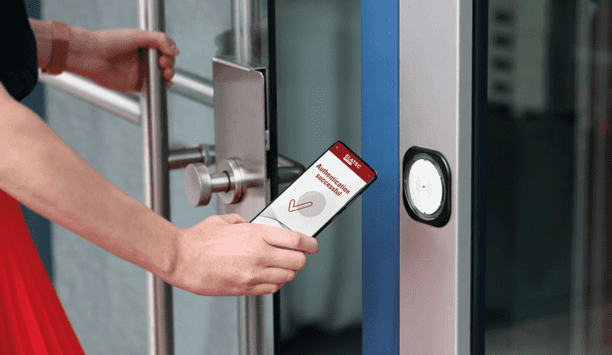
Physical access control
Download
The key to unlocking K12 school safety grants
Download
Access management in higher education
Download
School security checklist
Download
Why SAAS Security Platform is more popular in American SMEs
Download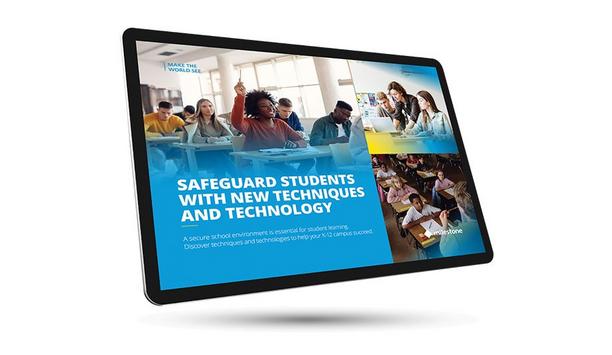
Safeguard Students With New Techniques And Technology
Download
Assessing safety readiness for education campuses
Download
The critical role of access control in K-12 school security
Download
Protecting dormitory residents and assets
Download
School security moves to the cloud
Download
Physical access control in higher education
Download
6 questions to ask when choosing a security system
Download
How end-to-end video security solutions can help your organisation with social distancing
Download
Building a safe ecosystem for visitors post COVID-19
Download
Schooling the market on education security
Download

Videos
School security: Manufacturers & Suppliers

A modern guide to data loss prevention
Download
7 proven solutions for law enforcement key control and asset management
Download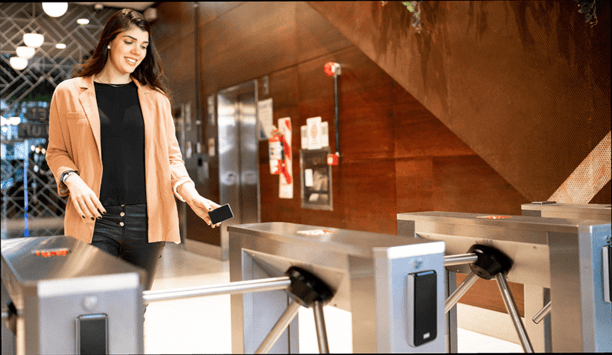
The truth behind 9 mobile access myths
Download
Access control system planning phase 2
Download
Security practices for hotels
Download

